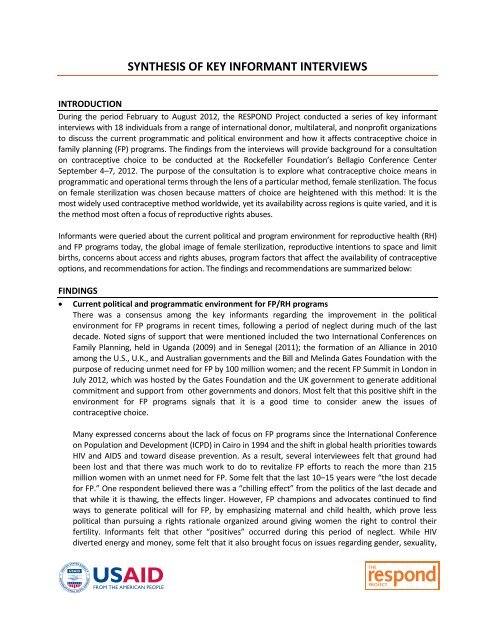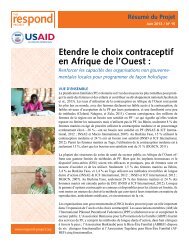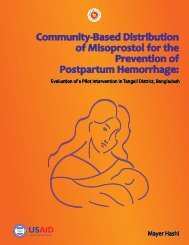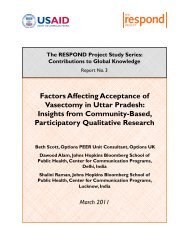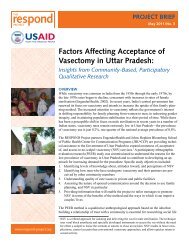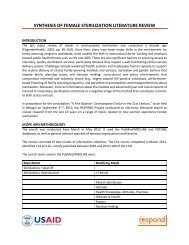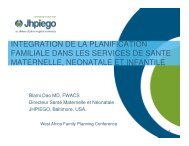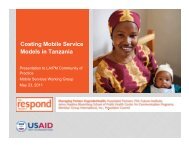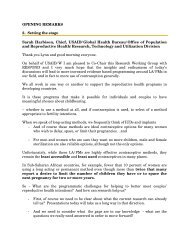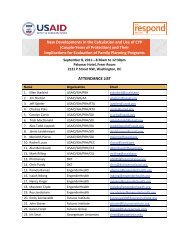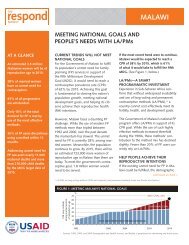synthesis of key informant interviews - the RESPOND Project!
synthesis of key informant interviews - the RESPOND Project!
synthesis of key informant interviews - the RESPOND Project!
You also want an ePaper? Increase the reach of your titles
YUMPU automatically turns print PDFs into web optimized ePapers that Google loves.
SYNTHESIS OF KEY INFORMANT INTERVIEWS<br />
INTRODUCTION<br />
During <strong>the</strong> period February to August 2012, <strong>the</strong> <strong>RESPOND</strong> <strong>Project</strong> conducted a series <strong>of</strong> <strong>key</strong> <strong>informant</strong><br />
<strong>interviews</strong> with 18 individuals from a range <strong>of</strong> international donor, multilateral, and nonpr<strong>of</strong>it organizations<br />
to discuss <strong>the</strong> current programmatic and political environment and how it affects contraceptive choice in<br />
family planning (FP) programs. The findings from <strong>the</strong> <strong>interviews</strong> will provide background for a consultation<br />
on contraceptive choice to be conducted at <strong>the</strong> Rockefeller Foundation’s Bellagio Conference Center<br />
September 4–7, 2012. The purpose <strong>of</strong> <strong>the</strong> consultation is to explore what contraceptive choice means in<br />
programmatic and operational terms through <strong>the</strong> lens <strong>of</strong> a particular method, female sterilization. The focus<br />
on female sterilization was chosen because matters <strong>of</strong> choice are heightened with this method: It is <strong>the</strong><br />
most widely used contraceptive method worldwide, yet its availability across regions is quite varied, and it is<br />
<strong>the</strong> method most <strong>of</strong>ten a focus <strong>of</strong> reproductive rights abuses.<br />
Informants were queried about <strong>the</strong> current political and program environment for reproductive health (RH)<br />
and FP programs today, <strong>the</strong> global image <strong>of</strong> female sterilization, reproductive intentions to space and limit<br />
births, concerns about access and rights abuses, program factors that affect <strong>the</strong> availability <strong>of</strong> contraceptive<br />
options, and recommendations for action. The findings and recommendations are summarized below:<br />
FINDINGS<br />
Current political and programmatic environment for FP/RH programs<br />
There was a consensus among <strong>the</strong> <strong>key</strong> <strong>informant</strong>s regarding <strong>the</strong> improvement in <strong>the</strong> political<br />
environment for FP programs in recent times, following a period <strong>of</strong> neglect during much <strong>of</strong> <strong>the</strong> last<br />
decade. Noted signs <strong>of</strong> support that were mentioned included <strong>the</strong> two International Conferences on<br />
Family Planning, held in Uganda (2009) and in Senegal (2011); <strong>the</strong> formation <strong>of</strong> an Alliance in 2010<br />
among <strong>the</strong> U.S., U.K., and Australian governments and <strong>the</strong> Bill and Melinda Gates Foundation with <strong>the</strong><br />
purpose <strong>of</strong> reducing unmet need for FP by 100 million women; and <strong>the</strong> recent FP Summit in London in<br />
July 2012, which was hosted by <strong>the</strong> Gates Foundation and <strong>the</strong> UK government to generate additional<br />
commitment and support from o<strong>the</strong>r governments and donors. Most felt that this positive shift in <strong>the</strong><br />
environment for FP programs signals that it is a good time to consider anew <strong>the</strong> issues <strong>of</strong><br />
contraceptive choice.<br />
Many expressed concerns about <strong>the</strong> lack <strong>of</strong> focus on FP programs since <strong>the</strong> International Conference<br />
on Population and Development (ICPD) in Cairo in 1994 and <strong>the</strong> shift in global health priorities towards<br />
HIV and AIDS and toward disease prevention. As a result, several interviewees felt that ground had<br />
been lost and that <strong>the</strong>re was much work to do to revitalize FP efforts to reach <strong>the</strong> more than 215<br />
million women with an unmet need for FP. Some felt that <strong>the</strong> last 10–15 years were “<strong>the</strong> lost decade<br />
for FP.” One respondent believed <strong>the</strong>re was a “chilling effect” from <strong>the</strong> politics <strong>of</strong> <strong>the</strong> last decade and<br />
that while it is thawing, <strong>the</strong> effects linger. However, FP champions and advocates continued to find<br />
ways to generate political will for FP, by emphasizing maternal and child health, which prove less<br />
political than pursuing a rights rationale organized around giving women <strong>the</strong> right to control <strong>the</strong>ir<br />
fertility. Informants felt that o<strong>the</strong>r “positives” occurred during this period <strong>of</strong> neglect. While HIV<br />
diverted energy and money, some felt that it also brought focus on issues regarding gender, sexuality,
stigma, and marginalized populations that are important for RH/FP programs as well. O<strong>the</strong>rs felt that<br />
<strong>the</strong> increased attention during <strong>the</strong> past few years on integration and on health systems streng<strong>the</strong>ning<br />
was also important, as vertical FP programs are less likely to be sustained.<br />
<br />
Global image <strong>of</strong> sterilization<br />
Most believed that <strong>the</strong> overall global image <strong>of</strong> female sterilization among political and program<br />
leaders is at best neutral. Several <strong>informant</strong>s said that not enough people know that female<br />
sterilization is <strong>the</strong> most widely used method in <strong>the</strong> world. There is an overall absence <strong>of</strong> dialogue<br />
about <strong>the</strong> issue, and when it is mentioned, it is usually in <strong>the</strong> context <strong>of</strong> concerns regarding incentives<br />
and human rights abuses. Many said that its image depends on what countries or regions are being<br />
discussed or “who you are talking to.” In many Asian and Latin American countries, female sterilization<br />
is widely used (some said overused), but <strong>the</strong> experience has been much less positive overall in Africa,<br />
with a few notable exceptions (Kenya and Malawi).<br />
All <strong>key</strong> <strong>informant</strong>s believed that female sterilization is an appropriate option within FP programs for<br />
women who have completed <strong>the</strong>ir family size; several <strong>key</strong> <strong>informant</strong>s representing international donor<br />
organizations believed that it is an important method and that efforts are needed to ensure it is<br />
included in FP programs. Some felt that stigma is no longer a major issue, while o<strong>the</strong>rs believed that<br />
<strong>the</strong> method is plagued by poor press and a history <strong>of</strong> abuse. Several <strong>informant</strong>s said that with a shift <strong>of</strong><br />
global development priorities to Africa, sterilization has lost some relevance at <strong>the</strong> global level, since<br />
African FP programs are focused more on birth spacing than on fertility limitation, and it is assumed<br />
cultural barriers for female sterilization are greater than for o<strong>the</strong>r modern methods <strong>the</strong>re. In addition,<br />
some <strong>informant</strong>s argued that female sterilization is part <strong>of</strong> <strong>the</strong> method mix in countries with more<br />
“mature” programs but that <strong>the</strong> health care infrastructure in Africa is too poor to accommodate <strong>the</strong><br />
addition <strong>of</strong> female sterilization in a significant way. One <strong>informant</strong> <strong>the</strong>orized that female sterilization<br />
has been “crowded out” by program trends that favored <strong>the</strong> community‐based and private‐sector<br />
provision <strong>of</strong> contraception and that have deemphasized systems for clinical care.<br />
One respondent characterized female sterilization as <strong>the</strong> method <strong>of</strong> “last resort/next resort,” meaning<br />
that program leaders <strong>of</strong>ten find reasons to put <strong>of</strong>f tackling <strong>the</strong> political and system challenges that<br />
must be overcome in making it available. It also is considered <strong>the</strong> method <strong>of</strong> last resort by a woman<br />
who, it is assumed, would do anything else before resorting to permanently ending her fertility.<br />
Ano<strong>the</strong>r respondent indicated that she, too, had believed that female sterilization was not appropriate<br />
in Africa—until she saw <strong>the</strong> numbers <strong>of</strong> women lining up for mobile services (in Kenya) when <strong>the</strong><br />
method was <strong>of</strong>fered and <strong>the</strong> resulting satisfied clients.<br />
<br />
Concerns regarding access barriers “versus” rights abuses<br />
Interviewees were asked how <strong>the</strong>y balanced concern about <strong>the</strong> “two sides <strong>of</strong> contraceptive choice,”<br />
defined as women experiencing “no barriers” and “no coercion” to use a contraceptive method. While<br />
all <strong>informant</strong>s felt that both issues were important and <strong>the</strong>re is no dichotomy between ensuring choice<br />
and protecting against coercion, <strong>the</strong> majority expressed greater urgency about <strong>the</strong> need to remove <strong>the</strong><br />
barriers that women face in accessing contraception than concern about coercion. While coercion is<br />
an egregious abuse <strong>of</strong> individual rights, most felt that its occurrence was limited and that <strong>the</strong><br />
international community has learned how to monitor and address abuses when <strong>the</strong>y happen.<br />
However, a few respondents expressed concern about <strong>the</strong> existence <strong>of</strong> more nuanced situations<br />
where choice may be compromised, such as in programs that include performance‐based financing <strong>of</strong><br />
particular contraceptive methods or that experience provider bias toward certain methods. One<br />
2 | Syn<strong>the</strong>sis <strong>of</strong> Key Informant Interviews
espondent indicated her hope that a result <strong>of</strong> <strong>the</strong> FP Summit would be a deeper discussion about payfor‐performance<br />
plans and when payments or incentives to providers are appropriate. Rights are<br />
hampered by poor quality <strong>of</strong> services and whe<strong>the</strong>r a health system is oriented to clients’ preferences<br />
and reproductive intentions.<br />
<br />
<br />
Reproductive intent for limiting<br />
Many respondents noted that <strong>the</strong>re is a significant unmet need among women who intend to limit<br />
future pregnancies and that it is especially important to reduce unwanted pregnancies for this group.<br />
Most respondents felt that programs pay overwhelming attention to <strong>the</strong> needs <strong>of</strong> those who are<br />
interested in spacing births, particularly given <strong>the</strong> use <strong>of</strong> <strong>the</strong> maternal health rationale for promoting<br />
FP. However, some felt that programs are more likely to address spacing because it is less politically<br />
charged than talking about limiting. One respondent noted that from a demographic standpoint, <strong>the</strong><br />
young age structures <strong>of</strong> many countries imply that spacing issues are more pressing; however, systems<br />
need to prepare for when <strong>the</strong>se people age and <strong>the</strong>ir reproductive intentions shift toward limiting.<br />
Program factors that affect sterilization as a contraceptive option<br />
The respondents provided many ideas about <strong>the</strong> factors that affect <strong>the</strong> position <strong>of</strong> female sterilization<br />
within <strong>the</strong> global discourse on contraception and its availability in countries. Most respondents noted<br />
that support for female sterilization has waned, given donors’ interest in supporting <strong>the</strong> availability <strong>of</strong><br />
long‐acting contraception. Since <strong>the</strong> IUD is effective for 15 years and lower‐cost implants have become<br />
real options in many countries, <strong>the</strong> rationale for providing a surgical option seems to have lessened.<br />
One respondent noted that <strong>the</strong>re are passionate advocates for expanding access to implants and IUDs,<br />
but none for sterilization. O<strong>the</strong>rs noted that initiatives to address contraceptive security are focused<br />
on “products” and “commodities” and that surgical methods are absent from <strong>the</strong> conversation. Also, a<br />
few respondents noted <strong>the</strong> tendency for <strong>the</strong> international community to focus on utilizing new<br />
technologies ra<strong>the</strong>r than expanding <strong>the</strong> use <strong>of</strong> <strong>the</strong> “old.”<br />
Many respondents expressed <strong>the</strong> view that investing in sterilization was perceived by planners and<br />
managers to be just “too hard a slog,” despite its cost‐effectiveness and potential contribution as an<br />
option for women who would prefer a one‐time option and who do not want hormonal methods or an<br />
IUD. Without a different approach and renewed attention, some felt that female sterilization use<br />
would continue to plateau or lose ground in FP programs.<br />
A few respondents noted that programmatic effectiveness is measured by overall contraceptive<br />
prevalence and by couple‐years <strong>of</strong> protection; however, <strong>the</strong> same kind <strong>of</strong> attention is not given to<br />
contraceptive method mix as an indicator. What constitutes an appropriate method mix is a question<br />
that is difficult to answer, as <strong>the</strong>re is no “ideal mix”; however, more attention is needed to understand<br />
and address <strong>the</strong> skews that exist and that represent <strong>the</strong> lack <strong>of</strong> overall choice in programs.<br />
Regarding factors at <strong>the</strong> country level, <strong>the</strong>se are organized below into three distinct categories<br />
following EngenderHealth’s Supply, Enabling Environment, and Demand (SEED) programming model.<br />
By far, most <strong>of</strong> <strong>the</strong> comments concerned barriers to supply, although two respondents thought that<br />
demand factors were equally important.<br />
Supply Factors<br />
Human capacity and infrastructure requirements were <strong>the</strong> factors most <strong>of</strong>ten mentioned by<br />
respondents as limiting <strong>the</strong> availability <strong>of</strong> <strong>the</strong> method. Many felt that <strong>the</strong> lack <strong>of</strong> skilled and competent<br />
providers was <strong>the</strong> main barrier that needed to be overcome. When it is <strong>of</strong>fered, <strong>the</strong>re is an urban bias,<br />
and it is less available for rural, hard‐to‐reach populations. Lack <strong>of</strong> FP in preservice training for<br />
3 | Syn<strong>the</strong>sis <strong>of</strong> Key Informant Interviews
clinicians is a <strong>key</strong> problem, given <strong>the</strong> overall neglect <strong>of</strong> FP in recent years. “As FP goes, so goes<br />
sterilization, but even more so.” In low‐prevalence countries, one called <strong>the</strong> dearth <strong>of</strong> providers in<br />
quality sterilization services a “Catch‐22,” in which <strong>the</strong> lack <strong>of</strong> practice leads to low quality <strong>of</strong> care,<br />
which undermines <strong>the</strong> method and its use. Poor quality <strong>of</strong> care leads to failure, infection, poor<br />
counseling, and in some programs, subtle and not‐so‐subtle coercion.<br />
O<strong>the</strong>r important supply‐related factors noted by <strong>the</strong> respondents include <strong>the</strong> lack <strong>of</strong> dedicated space<br />
and time available at overcrowded facilities (usually at <strong>the</strong> district level) for elective surgery for<br />
contraception. One respondent noted, “Why should voluntary sterilization be done in a weak system?<br />
Since IUDs are as good as a permanent option, programs should start with o<strong>the</strong>r methods before<br />
adding female sterilization.” O<strong>the</strong>rs felt that surgical contraception programs have <strong>the</strong> added benefit<br />
<strong>of</strong> streng<strong>the</strong>ning <strong>the</strong> capacity <strong>of</strong> both providers and systems to <strong>of</strong>fer quality facility‐based services.<br />
Mobile outreach strategies were <strong>of</strong>ten mentioned as means for addressing <strong>the</strong> supply barriers.<br />
Respondents were mixed about <strong>the</strong> strategy, with some praising it as a solution for overcoming health<br />
system inadequacies and expanding choice while keeping cost down. However, a few respondents<br />
questioned <strong>the</strong> consequences related to managing follow‐up and continuity <strong>of</strong> care.<br />
Enabling Environment Factors<br />
Many respondents mentioned that a <strong>key</strong> barrier affecting <strong>the</strong> availability <strong>of</strong> female sterilization is <strong>the</strong><br />
upfront cost <strong>of</strong> providing and <strong>of</strong> obtaining <strong>the</strong> service. Many lamented that <strong>the</strong>re are no recent data<br />
on <strong>the</strong> costs and benefits to programs and individuals <strong>of</strong> <strong>of</strong>fering female sterilization as an option.<br />
O<strong>the</strong>rs felt that although most countries espouse rights‐based rationales for FP, <strong>the</strong>y pay little real<br />
attention or devote little advocacy to women’s health and choice. As one respondent said, “Programs<br />
don’t listen to women. What is easier? Getting a sterilization procedure or using a temporary method<br />
for 30‐plus years?”<br />
Some respondents noted that variations in <strong>the</strong> availability <strong>of</strong> sterilization within <strong>the</strong> method mix<br />
depend on program context and history. It is available in countries where it was promoted or<br />
emphasized and became normative in terms <strong>of</strong> provision as well as use. One respondent expressed a<br />
minority view by stating, “If people are happy with one‐method programs, <strong>the</strong>n it might be OK. It is<br />
hard to get rid <strong>of</strong> provider bias, but even that could be OK if women are well served.”<br />
Demand Factors<br />
The majority <strong>of</strong> respondents said that one <strong>of</strong> <strong>the</strong> biggest barriers to female sterilization is <strong>the</strong> lack <strong>of</strong><br />
accurate information regarding <strong>the</strong> method. Like all contraceptive methods, female sterilization is<br />
subject to myths and misconceptions and, in many countries, it has a negative image that is difficult to<br />
overcome. Many mentioned <strong>the</strong> existence <strong>of</strong> cultural norms on fertility and gender as contributing to <strong>the</strong><br />
barriers for women to access a permanent method. Little is currently known about <strong>the</strong> characteristics<br />
and motivations <strong>of</strong> women who choose this method, as most studies about choice and female<br />
sterilization in developing countries date back to <strong>the</strong> 1980s and 1990s. Fur<strong>the</strong>r, one respondent asked,<br />
“What would women choose in <strong>the</strong> absence <strong>of</strong> barriers?” perhaps with <strong>the</strong> underlying implication that<br />
that no one would choose sterilization unless <strong>the</strong>re were no o<strong>the</strong>r options available.<br />
O<strong>the</strong>rs mentioned that barriers may result from a lack <strong>of</strong> counseling‐related skills among providers and<br />
that programs compensate by building in requirements (age, parity, spousal consent) that impede<br />
access and show little faith in women’s decision‐making ability. Some felt that providers worried about<br />
regret and about changed circumstances (marital status or number <strong>of</strong> male children), and that <strong>the</strong>se<br />
might result in retaliation from angry spouses toward <strong>the</strong> wife (and <strong>the</strong> provider).<br />
4 | Syn<strong>the</strong>sis <strong>of</strong> Key Informant Interviews
RECOMMENDATIONS<br />
Respondents provided <strong>the</strong>ir thoughts on recommendations for how to improve contraceptive choice<br />
overall and what might be done to increase attention to and availability <strong>of</strong> female sterilization as an option<br />
within FP programs. With respect to choice, <strong>the</strong>re were several recommendations to reorient<br />
policymakers and providers to <strong>the</strong> “nuances” <strong>of</strong> choice. It is important not only to have in place policies<br />
that protect individuals from abusive and coercive practices, but also to understand <strong>the</strong> broader<br />
limitations on choice that affect women’s ability to access <strong>the</strong> contraceptive methods that <strong>the</strong>y need and<br />
want. A few respondents recommended that providers be trained to deal with rights. Several discussed<br />
<strong>the</strong> importance <strong>of</strong> ensuring that <strong>the</strong> method is included in clinicians’ preservice training and that more<br />
attention be devoted to task‐shifting responsibility for sterilization to clinical <strong>of</strong>ficers in places where <strong>the</strong>re<br />
are physician shortages. O<strong>the</strong>rs thought that more energy should be devoted to finding new ways or<br />
technologies appropriate for low‐resource settings and pain management. Mobile outreach services were<br />
recommended by several respondents, although a few countered with cautionary concerns.<br />
Many <strong>informant</strong>s suggested a research agenda to support advocacy for improved contraceptive choice and<br />
proposed studies to better understand <strong>the</strong> costs and benefits <strong>of</strong> voluntary sterilization for individuals and<br />
health systems; case studies <strong>of</strong> countries that have successful program efforts that include voluntary<br />
sterilization; client studies that address use‐dynamics and decision making about contraceptive choices;<br />
and research on <strong>the</strong> effects <strong>of</strong> incentives. One respondent recommended an effort to advance female<br />
sterilization similar to one implemented over <strong>the</strong> last several years by a large foundation to support <strong>the</strong><br />
availability <strong>of</strong> long‐acting methods. He suggested a demonstration project that would provide an infusion<br />
<strong>of</strong> funding and technical assistance to “bring it all toge<strong>the</strong>r” in 2–3 countries with enough <strong>of</strong> a developed<br />
health system (e.g., Ethiopia) and with a high unmet need for limiting, to demonstrate <strong>the</strong> resources<br />
required to provide quality, scaled‐up services and show that female sterilization is an appropriate and<br />
desired option among women.<br />
Finally, <strong>the</strong>re was a call to “listen to women” and to focus attention on addressing <strong>the</strong>ir needs and<br />
preferences throughout <strong>the</strong> reproductive life cycle. One respondent said that we need to reorient health<br />
systems so that <strong>the</strong>re is “more counseling, more listening, and more faith in women.”<br />
5 | Syn<strong>the</strong>sis <strong>of</strong> Key Informant Interviews


